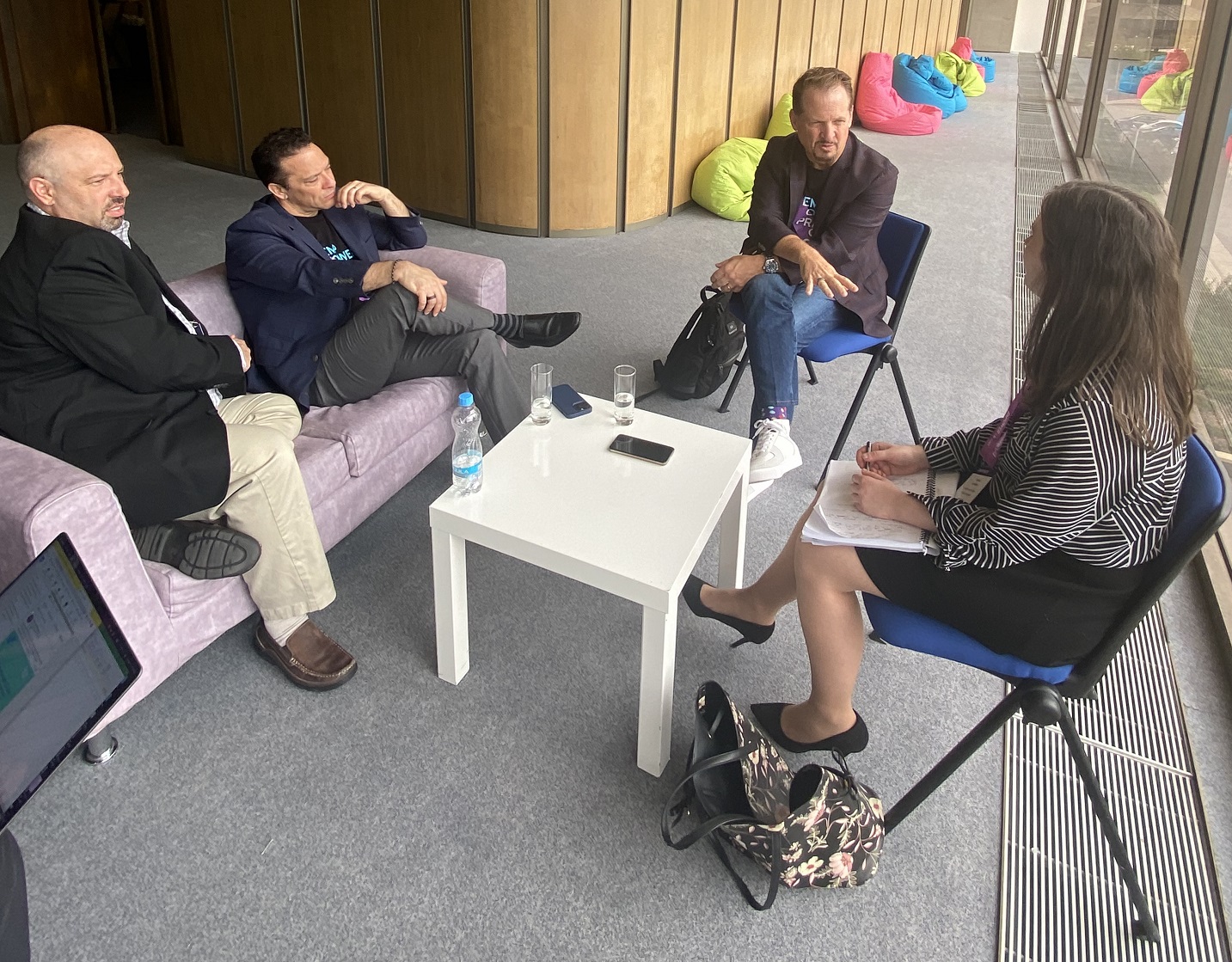One of the key themes of this year’s Empower conference from N-able is seeing opportunity rather than threat in emerging technology.
We spoke about just that to three members of N-able’s leadership team:
John Pagliuca: CEO and general manager
Mike Adler: EVP and head of technology and product development
Kevin Bury: SVP and head of customer service
Here’s what they had to say.
One of the themes of this conference is seeing opportunity rather than threat. How can you engage that kind of mindset when it comes to AI?
Mike: There have been moments over the last 25 years, where I think we all realised we were on the precipice of some major change, but really couldn’t define it at the time. Looking back on it now, we think ‘Oh, wow, that was obvious.’ I really think we’re at one of those places.
So, you could be terrified of that technology and stay behind. It leaves you at risk of not understanding it. As I describe it with my grandparents and mobile phones, you just told ballparks of behind and now you can’t reliably interact in the new world. That’s a hard thing to do. Instead of looking at it from a fear perspective, you can experiment, you can explore, you can go find places where this technology may help to impact my business. We’ve seen some great examples from our partners where they have started to experiment and use it in very simple ways to help them adjust customer communication. Their technicians, who either because of language skills or just because they’re technical or maybe aren’t great customer service representatives, are using it to create customer communications or to edit and improve their customer communications. Now they can more rapidly lead a customer that they’ve received an issue from and are going to be able to prioritise it and handle it appropriately.
We saw another example from a partner that’s leaning in to using some of these generative AI to help their technicians more greatly understand the content of the problem. So, as opposed to a technician spending six minutes to read a long email and figure out what’s going on, they feed it into the generative AI, and have it summarise it in seven to 10 keywords. Think about just that little bit now relatively innocuous, relatively easy, but great experimentation, to look for opportunities to use these new technologies to help their businesses become more efficient, help their people be more productive. You can lean in, and we’ll all see together as these things continue to impact.
If you stay aside, if you look at that fear, I just don’t think you’re taking advantage of these opportunities to actually assist your business. We’re seeing our partners really do that. We want to encourage that. Then gather their feedback so that we can figure out ways in which we can help them scale out those offerings and provide possibly new technologies and build on those generative AI and machine learning techniques to really help a broader offering that they may not be able to tackle on their own, but because they became aware, because of their learning and thought process.
John: The line between opportunity and threat really depends on whether you can keep up with that rate of change. If you’re able to keep up with this rate of change, then it’s a huge opportunity, because now you can be the shepherd for those that are falling behind. If you’re leveraging technology and leaning in, you have that competitive advantage.
Kevin: Building on that, one of our partners said:
“We’re viewing this as a way to be a step change in the productivity and efficiency of our team. We’re going to leverage AI to take the lead with this labour scarcity and be able to give ourselves such a step change that we will be up here from an overall efficiency, because we can’t get a plethora of people to throw at these things.
“If we can use the technology, it gives us such a competitive advantage that will be miles ahead. We think we’re going to get such an early start to this, that our competitors won’t be able to catch us.”
I think it’s a really interesting perspective. You can view it as a threat – while the world is changing, it’s going to displace all these jobs. Or you can say this is a way for me to gain a competitive advantage to be able to serve my partners in a much more efficient way.
There’s such a compelling argument to invest in your people. How much what proportion of budget should really be going into training people to keep up with these changes?
Kevin: You need to be committed from a philosophical point of view into growing and developing your people, giving them the opportunity to do training. As we all know, training is oftentimes one of the very first things that get cut when times get tough. But I think if you lean into it and say, ‘Look, we are going to be committed to this because we don’t view it as a threat. And by the way, doing nothing makes it more of a threat.’ Leaning in and doing anything, giving them the space to experiment with it.
Mike’s talked about some of these little test prep checks. They’re just tiny little things. We heard one that said that they did an investment of about six hours of programming, about $50 a month, saves them on average 40 per cent of one person’s frontline time a day. That’s just a matter of a tiny little experiment that someone just went off and did on the weekend. Now they’re getting that kind of return already. I think that’s a different way of doing training because the best way to experiment with this is to do it hands on.
How does a business protect themselves from the risk of impersonation?
Mike: I think right now they have to generate is creating the source of truth. What I mean by that is, what is the trust period? How do you build trust? How do you distinguish yourself? It’s really about knowing that I communicate from a trusted source and a trusted pattern in a trusted way. We have a distinct pattern in how we communicate with our customers – a transparency level that we’re going to use to deal with our customers. We use certified emails that come with a certain pattern. It would be harder to impersonate us online, and virtually, because you’d have to replicate this.
I think that really is true for any small businesses to identify the ways in which you want to communicate and sort of build that source of truth in that pattern that makes sense. If you typically communicate over the phone, and then suddenly, folks are getting Twitter messages, that’s probably not the right thing. It’s going to look suspicious. We are at the very early days, and obviously, I use the impersonation avenue, which I think is unexplored risks that we’re still just learning as a society, frankly. But it’s an interesting set, it presents some interesting challenges as we move forward. It’s not clear how we will be able to distinguish the real from the generator. And I think there are plenty of examples that we’ve all seen around videos being created, picture manipulation, audio-visual manipulation. There’s a hole appearing on social media and some of that, and so it’s I think it’s as much as possible, trying to use verified channels and verified patterns of communication that are harder to swap out.
Kevin: This is very early days to Mike’s point. We don’t know what we’re going to experience yet as this thing grows and evolves and becomes part of our everyday lives. We’re going to have to be very cognizant of what’s going on and see what these new threats are, and there will be opportunities for us to get ahead of that, and to be able to respond to some of those things. I think it’s exciting for me when I look at it.
And you know, Mike, you talked about these inflection points over the last 25 years, we’re very much on the cusp of noon, right? Maybe it’s not so much on the customer in the early days of it, though. There are going to be a lot of learnings and things that we will all as a society experience. So, we’re all going to learn as we see the possibilities and the threats of generative AI.
A final question to all of you. What kind of threats/opportunities do you think businesses should be aware of in the next five years?
Mike: I think small and medium-sized businesses need to complete that journey to the cloud, we know that it’s happening. I think there still are small-medium-sized businesses who see it as a risk. It’s an unknown, it’s complex. We want to give them the opportunity to allay those fears and be able to take advantage of those opportunities. I think that’s one thing that we want to encourage our MSPs to do, obviously, also help them to do so more profitably.
But what we’ve heard from businesses, from our partners, and even small enterprises is they’ve not been able to do it and do it efficiently and in a cost-effective way. We’ve driven accurately just from the cost of the business as opposed to additional opportunities.
Machine learning and artificial intelligence as a whole, recognising that we have labour shortages in the market and that some of these technologies on hold will enable you to get more out of the people that you have, and also be able to help those people develop new skills. We talked about investing in your people. There’s an idea that as you adopt better, newer technologies, you drive interest in learning and your people, they also find it to be a better place to work, which means you have folks who want to stay with you longer, keeping that expertise inside your organisations – that’s only better for organisations across the board. It’s less about using technology to replace people. It’s using the technology to enhance people to give them better experiences and make them more productive, to allow them to learn these skills and provide better service.
I do think that third opportunity is really helping small medium sized businesses protect themselves and their employees from a very complex cybersecurity and risk area. Governments are getting more engaged and more involved in regulation. We can help organisations understand what their requirements are and help them meet those requirements. So that they themselves can show their customers that they are operating properly, and secure passion and protecting data appropriately in those that meet those regulations, both for their customers and obviously for the appropriate regulatory agency. And that’s not a scary thing. I think some folks see some of these regulations as complex and impactful to businesses.
There’s been a theme in some of our European customers as some of the regulations have come down and the impact on their businesses and what’s going to happen. There’s also an opportunity to step into those things and use some solutions and use some expertise, use some services from our MSP partners to help demonstrate that actually, they’re not that complex, and we can meet them and we can show you know, put the stamp of approval and state to our customer base. Not only are we checking the boxes, regulations, we’re living into them, and doing exactly what the law requires them to do and more in a way that we can be proud of.
John: I’d say be deliberate about the services that you want to offer your customers, be deliberate on how you want to use your most expensive resource – people. Right outside this window, I’m watching a guy use a push mower to mow the lawn. And then he’s emptying the bag and dumping it in, right? And so they’re saying, ‘Hey, I’m not valuing that resource because what we could do is have a ride-in lawnmower that can be automated, and he doesn’t have to dump the grass. He can be using technology and automation to augment the experience of the human, or this robotic lawnmower, that he doesn’t even need to be there. It can actually be servicing by itself. You can augment the experience with your resource or you can eliminate the need for the resource to do that. They can go do better things. You can be deliberate on how you service the customer. If you’re not deliberate and having a strategy as to what you want to do, and how you want to service the customer and how they want to use your resource, you’re going to end up pushing a lawn mower, and not getting the best out of that resource for it, or the best experience for the customer.
There are different ways that you can use the technology. You can use it to augment the experience for your resource, or actually eliminate the need for that resource in general, so they can go and do something else. But if you’re not deliberate about it, you’re not going to advance and you’re going to be left behind.
Kevin: So I’m going to take that in a slightly different direction. Here’s the thing that and I see this firsthand in my role. Technology is not slowing down.
What’s really important for businesses is to not lose sight that it’s still about the personal relationships. We can’t lose sight of the fact that while technology advances, while generative AI is going to do things to augment and move things forward, and the threat actors are going to get more and more innovative and capable, it still comes down to personal relationships. And you can’t lose that. That’s why, even though I get excited about the opportunities, we need to help people understand you need to have personal relationships, and they’re not going to get displaced by these technologies.
People are terrified. They’re scared because it’s it’s brand new territory of, well, ‘It’s going to replace all my employees.’ It’s not going to replace all your employees. It’s going to make them more capable. But if we don’t focus on those human connections, those relationships, it’s not going to help us advance as a society.
Read more
What is generative AI and its use cases? – Generative AI is the is a technological marvel destined to change the way we work, but what does it do and what are its use cases for CTOs?
ChatGPT vs alternatives for programmers – ChatGPT and its alternatives are set to be especially useful for programmers writing code. But just how reliable is the technology for developers? Antony Savvas considers what’s available and what the alternatives are
Eight steps to a successful AI implementation – In this article, we outline the eight key implementation steps to help AI and machine learning deliver on its full potential










